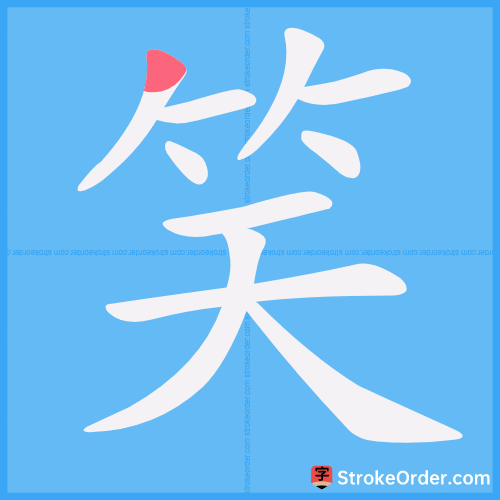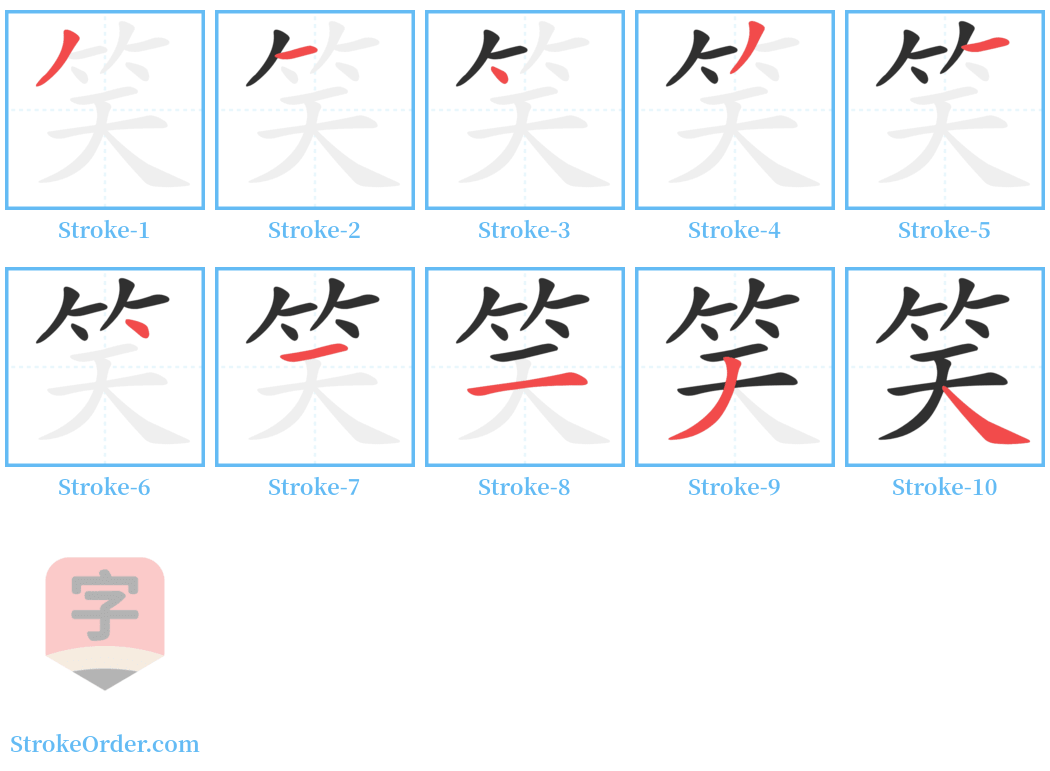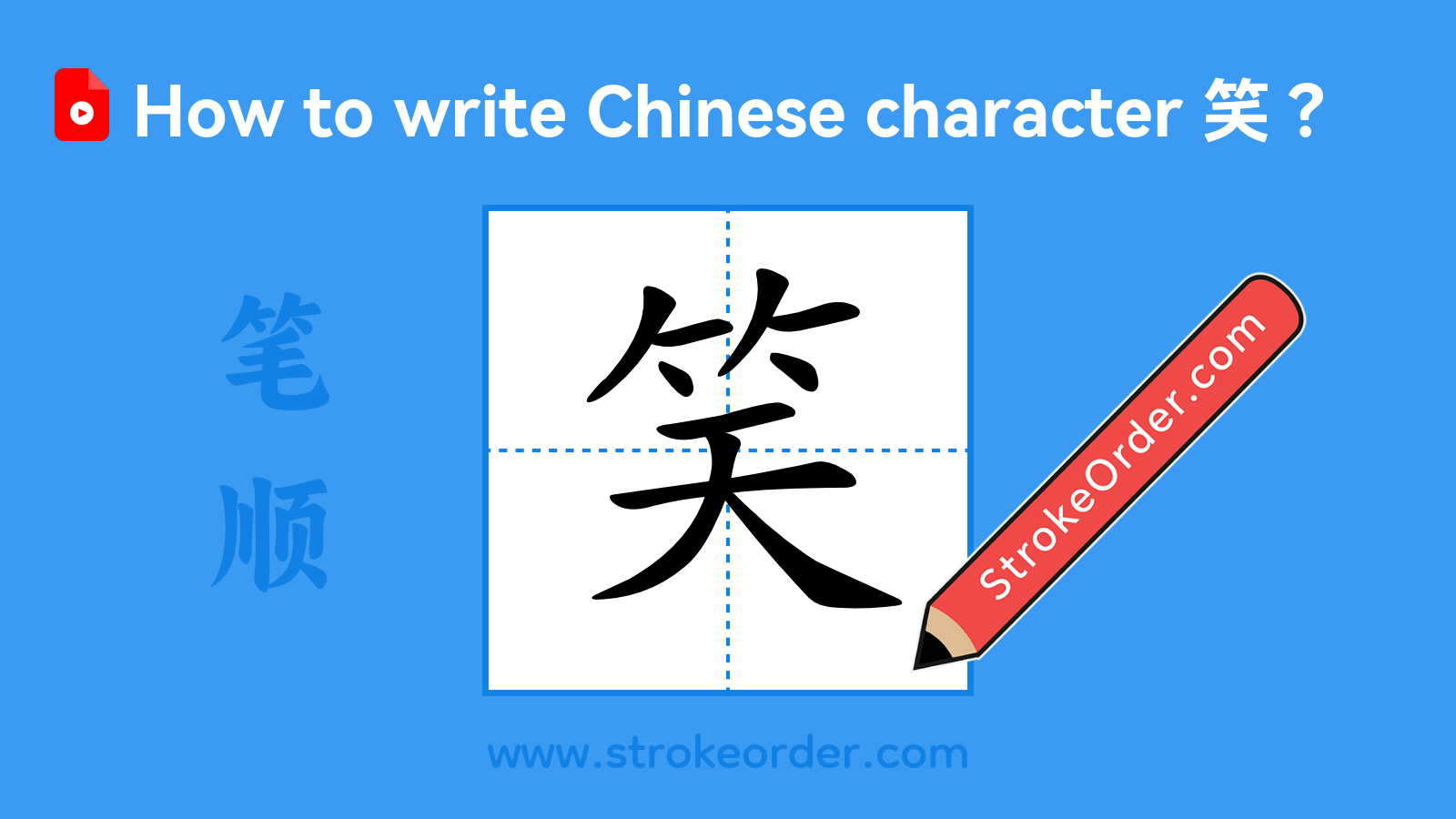笑 Stroke Order
Animated Stroke Order of 笑

Stroke Order Diagrams for 笑

Step-by-Step Handwriting Guide for 笑

Learn to Write Chinese Characters with Video Tutorials
Watch the video of writing the Chinese character "笑", learn the correct stroke order (笔顺) of the character "笑", and master the standard way of writing the character "笑".

Free Printable Handwriting Practice with Stroke Order: 笑
Printable Writing Practice Worksheet of "笑" in Portrait Orientation (Tian Zi Ge)

Printable Writing Practice Worksheet of "笑" in Landscape Orientation (Tian Zi Ge)

Information of 笑
Pinyinxiào
Radical
竹
Strokes
10 strokes
Usage
★★★★★
Definition
laugh / smile
笑 [xiào] 1. To display a joyful expression and emit cheerful sounds. - Examples: 笑容 (smiling face), 笑颜 (smiling appearance), 笑眯眯 (smiling with squinting eyes), 谈笑风生 (witty conversation). 2. To ridicule. - Examples: 笑柄 (object of ridicule), 笑话 (joke), 笑谈 (to jest), 贻笑大方 (to cause embarrassment), 嘲笑 (to mock), 见笑 (to be laughed at), 耻笑 (to ridicule). 【本义】: Because of joy, one smiles or makes a sound.【造字法】: Pictophonetic compound. From 竹 (bamboo), and 夭 (young). Yang Chengqing said, “Bamboo bends in the wind, just like a person smiling.” The character may derive from bamboo and young.Synonyms: 1. Same as the original meaning (English: smile; laugh). 2. To ridicule (English: ridicule). 3. Joke; make fun of (English: joke; make fun of). 4. To like; to admire (English: like). 5. Metaphorically represents flowers blooming (English: bloom; open). 【引】: 1. "说文":笑, 喜也. 杨承庆曰: “竹得风,其体夭屈,如人之笑也。” 2. "字林":竹为乐器,君子乐然后笑也. 朱骏声曰: “此字古皆从犬,本义犬狎人声也。从犬,箾省声。” 3. "易·萃": 一握为笑。 4. "诗·卫风·氓": 载笑载言。 5. 言笑晏晏。 6. "列子·汤问": 两小儿笑曰。 7. "论语·宪问": 乐然后笑,人不厌其笑。 8. "聊斋志异·狼三则": 止增笑耳。 9. "列子·汤问": 笑而止之。 10. 清· 周容《芋老人传》: 笑而不顾。 Examples: 1. 笑唏唏 (laughing happily), 笑咍咍 (laughing loudly), 笑浪 (laughing freely), 笑面夜叉 (a seemingly kind person with a cruel heart). 2. 贻笑大方: To create embarrassment through ridicule. 3. 笑嗷 (to laugh joyfully; to play), 笑乐院本 (a short play before the main performance), 笑耍头回 (an introductory story told before the main tale in traditional performance). 4. 喜爱 (to like), as in 笑眼传心 (to express feelings through smiles), 笑悦 (joyful laughter), 笑叹 (both laughable and lamentable). 5. 比喻花朵开放 (metaphor for flowers blooming), as in 笑笑 (a manner of blooming flowers), 笑靥金 (a nickname for chrysanthemums).
to have a smile on one's face
happy and gay / cheerful and gay / smilingly
to jeer at / to deride / to ridicule / mockery / derision
grinning / smiling
Laughing Mimi
smiling / with a smile
to roar with laughter / hoots of laughter / guffaw
the whole room roaring with laughter (idiom)
Laughter
laugh uproariously / roar with laughter / burst into a guffaw / a volley of laughter
to laugh heartily / to burst into loud laughter
to laugh involuntarily / Taiwan pr. [e4 ran2 shi1 xiao4]
uproarious laughter
lit. not to know whether to laugh or cry (idiom) / both funny and extremely embarrassing / between laughter and tears
lit. not to know whether to laugh or cry (idiom) / between laughter and tears
to sneer at
see 嬉皮笑臉|嬉皮笑脸[xi1 pi2 xiao4 lian3]
laugh merrily
laughter
enchanting smile
to smile sweetly
all smiles / smiling mischievously or ingratiatingly
to be laughing and playing / to giggle
lit. laughs, jeers, anger and invective (idiom) / fig. all kinds of emotions / to mock and scold / (of writing) freely roving / following the author's fancy
(literary) to sneer / to laugh at
smile / smiling expression / CL:副[fu4]
smile / CL:個|个[ge4],絲|丝[si1] / to smile
simper / smile fatuously
smiling wholeheartedly (idiom); beaming from ear to ear
to get people to laugh / funny / hilarious
Input Method for 笑
Pinyinxiao4
Wubi
ttdu
Cangjie
hhk
Zhengma
mmgd
Four Corner
88804
Unicode
U+7b11
Same Pronunciation Characters
削哮啸嚣孝宵小效晓校消淆潇硝笑箫肖萧销霄哓崤枭枵筱绡逍骁魈鸮傚嘯囂曉梟洨瀟猇簫蕭蟏蠨銷鴞啋呺憢恔踃謏灲灱侾恷虓庨宯焇婋萷硣翛痚痟窙揱綃嘐歊撨嘵獢膮彇藃蟂穘簘鴵謞蟰髇櫹嚻髐鷍驍毊虈郩訤誵暁筿皛篠皢効咲
Same Radical Characters
竹竿笋笑笙笛符笨第等筋筏筐筑筒答策筛筝筷筹签简箕算管箩箫箭箱篇篓篡篮篱篷簇簧簸簿籍竺竽笃笄笆笈笊笏笞笠笤笥笪笮笳笸笺笾筇筌筚筠筢筮筱筲筵箅箍箐箓箔箜箢箧箪箬箴箸篁篆篌篑篙篝篥篦篪篼篾簌簖簟籀籁笫笱筀
本文来自残情先生投稿,不代表汉字笔顺中文网英文版立场,如若转载,请注明出处:https://www.strokeorder.cn/strokeorder/24631.html

 微信扫一扫
微信扫一扫 